Recreational & Commercial Activities
| Operation of Restaurants | Operation of Bars, Discos and Karaokes |
Operation of Outdoor Entertainment Activities |
Operation of Restaurants
(Click here to understand more on our Green Restaurant Partnership Programme)
Air Pollution
| Common Problems | Causes | Relevant Environmental Control |
| Excessive emission of cooking odour & greasy fumes | Exhaust outlets locating too close to the nearby air sensitive receptors | Under the Air Pollution Control Ordinance, Cap. 311, all air emissions from a restaurant should not cause air pollution problem, including odour nuisance, and should be free from visible fume. Any person causing air nuisance must adopt air pollution abatement measures. |
| Inadequate air pollution control measures | ||
| Outdoor cooking activities |
Practical Solutions
- Take due environmental consideration in planning stage and carefully select business location with proper location and adequate space for placing exhaust outlets
- Avoid the exhaust outlets in close proximity to the air sensitive receptors for restaurants and food business
- Locate the exhaust outlets in a good ventilated and dispersive area, e.g. extending kitchen exhausts to rooftop
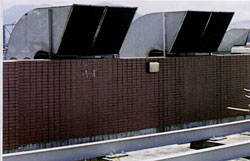
Locate the exhaust outlets at rooftop for better dispersion.
- Locate and orientate the exhaust away from the nearby air sensitive receptors
- Preference should be given to extend the exhaust to a level of at least 3m above the highest point of the restaurant's own building and any adjacent or attached buildings within a 20m radius
- Seek advice from environmental professionals when locating exhaust outlet
- Use smokeless fuel, such as gas and electricity
- No outdoor cooking, e.g. hotpot & BBQ
- Install appropriate air pollution control equipment (recent tests indicated that the combined use of electrostatic precipitator and hydrovent can remove up to 94% of oily fumes)
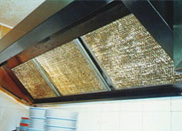
Grease Filter.
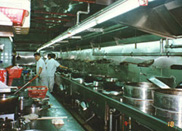
Hydrovent.
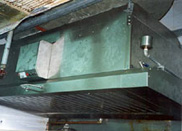
Electrostatic Precipitator.
- Install appropriate odour control equipment, such as activated carbon filter, for cooking activities which emit strong odour
- Conduct regular cleaning and maintenance of all air pollution control equipment
- Maintain an easy access for serving and inspecting air pollution control agent
- Monitor the quality of cooking fumes and odour emissions regularly during peak hours
- Install transparent inspection window/panel for the air pollution control equipment
- Adopt automatic switch-on function to synchronize the operation of the cooking device with air pollution control equipment
Noise & Vibration Pollution
| Common Problems | Causes | Relevant Environmental Control |
| Ventilation system noise | Too close to the nearby sensitive receivers | Under the Noise Control Ordinance, Cap. 400, noise caused at industrial or commercial premises should not cause the noise level at Noise Sensitive Receivers (NSRs) to exceed the limit stipulated under the relevant Technical Memorandum. |
| Inadequate noise pollution control measures | ||
| Alfresco dining noise | Too close to the nearby sensitive receivers | |
| Restaurant operation noise | Too close to the nearby sensitive receivers |
Practical Solutions
Ventilation System
- Place noisy equipment inside a plant room with thick walls as far as possible
- Locate the equipment away from the nearby and future NSRs
- Orientate the duct openings/air inlets/air outlets away from NSRs
- Choose equipment of low noise brands or models
- Make reference to the statutory noise limit and include noise levels specification when ordering new equipment
- Conduct regular maintenance, such as lubricating moving parts, tightening loosen parts (bolts/nuts, driving belts, panels, etc.), replacing worn-out components (bearings) and inspecting equipment alignment
- Implement proper noise control measures:
- Erect noise barrier, partial and completed enclosures to block the noise propagation path to the NSRs
- Install silencers at air inlets and outlets
- Install inertia block and vibration isolator to isolate the vibrating machines and prevent structural vibration transmission
- Apply damping material on the vibrating duct work
- Provide acoustic mat on the water surface of water cooling towers to reduce the water splashing noise
- Adjust the operation mode, such as reducing fan speed and switching off non-essential equipment at night
Alfresco Dining
- No cleaning & tidying up work after 11pm
- No music/karaoke in the vicinity of residential premises
Restaurant Operation Noise
- Select quiet cooking appliances
- Prohibit outdoor food preparatory works and washing activities at the backlanes
Water Pollution
| Common Problems | Causes | Relevant Environmental Control |
| Blockage of foul drain | Mal-function of grease trap, improper operation and inadequate maintenance of grease trap | Under Water Pollution Control Ordinance, Cap. 358, discharge of polluted waters into stormwater drains is not permitted, discharges of wastewater from all types of industrial, manufacturing, commercial, institutional and construction activities into sewers or elsewhere should comply with the terms and conditions of a license issued by the EPD. |
| Overflow of grease trap | Mal-function of grease trap, improper operation and inadequate maintenance of grease trap | |
| Discharge exceed the WPCO license limit | Mal-function of grease trap/sewage treatment plant, improper operation and inadequate maintenance of grease trap/sewage treatment plant | |
| Wastewater illegally discharged via stormwater drain or stormwater surface channel | Mis-connection/Expedient connection, improper change in drainage use, e.g. placing the washing machine at the rooftop and discharging wastewater via stormwater surface drain. | |
| Leakage of wastewater to roadside area | Backlane food preparatory works and washing activities |
Practical Solutions
Grease Trap
- Should apply WPCO licence from the EPD
- Locate grease trap away from the vicinity of common areas, such as lift lobbies or any fresh air intake of the air conditioning system
- Install above ground grease trap at an easily accessible location to facilitate ease of cleaning and maintenance
- Provide communal grease trap as far as possible for better efficiency and economy
- Use well-developed grease trap with provision for the daily removal of screened solids and trapped grease
- Maintain and operate the grease trap to meet the discharge license conditions, such as conducting self-monitoring checks and providing self-monitoring reports
- Install screening device at the grease trap inlet and remove the screened solids daily
- Remove the accumulated bottom sludge regularly
- Engage registered grease trap waste collector for regular cleaning and overhauling of grease trap
- Arrange the regular clearance in non-sensitive hours
- Properly archive cleaning records and always keep the cleaning records for the past 6 months for the EPD's inspection
Sewerage
- Conduct regular maintenance check on the condition and routing of the drainage system and repair any drainage defects immediately
- Keep an updated drainage plan in management office
- Check the drainage plan before carrying out of drainage works to ensure correct drainage route
- Conduct dye-tracing tests to confirm drainage routes
- Ensure the use of manhole cover with correct identification of the drain types
- Use color code to help identify and distinguish stormwater drainage system (e.g. manhole, exposed pipes and channel) from foul water system
Food Preparatory and Washing Activities
- Prohibit outdoor food preparatory works and washing activities at the backlanes
Operation of Bars, Discos and Karaokes
Noise & Vibration Pollution
| Common Problems | Causes | Relevant Environmental Control |
| Excessive music and singing noise | Too close to the nearby sensitive receivers | According to the relevant Technical Memorandum issued under Noise Control Ordinance, Cap. 400, noise from bars, discos, karaokes located inside a building should not exceed the statutory limit during daytime and evening (from 7am to 11pm) while the noise should not cause any noise annoyance to residents during nighttime (from 11pm to 7am). |
| Inadequate noise pollution control measures | ||
| Crowd noise | Too close to the nearby sensitive receivers |
Practical Solutions
-
Avoid setting up business with large scale sound amplification system in buildings in which people live
-
Install thick resilient pads underneath the sound speakers or their supports to reduce noise transmission through building structures to neighbours
- Avoid hanging large or strong bass sound speakers on the ceiling to reduce transmission of low frequency noise and vibration to other floors
-
Construct wooden suspended ceiling and attach sound absorbing materials to ceiling to reduce transmission of noise to other floors
-
Locate sound speakers away from corners of premises
-
Maintain the volume of your sound systems at low levels to avoid causing nuisance to neighbours. Install a sound limiter so as to prevent tampering with the sound volume setting
-
Install double-glazed noise insulation windows and ensure they are closed at all times when in business
-
Adopt noise abatement measures to avoid noise transmission from the shop to outside through openings (such as louvers, ventilating fan/exhaust/duct openings)
-
Install double doors which are made of sound insulation or absorption materials at the entrance to avoid noise leakage to outside
-
Install a signal alarm at the double doors so that when the two doors are open simultaneously, a signal will be generated to notify the responsible person to close the doors
-
Ensure the doors are closed when in business to avoid noise transmission from the shop to outside, so that the noises generated from the your premises will not be audible in the nearby noise sensitive receivers
- Warn the customers at the entrance not to scream and speak too loud in order not to create any noise annoyance to nearby residents
- Provide training to staff on noise control measures
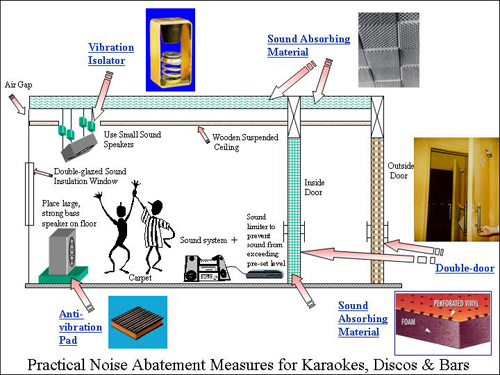
Operation of Outdoor Entertainment Activities
Air Pollution
| Common Problems | Causes | Relevant Environmental Control |
| Excessive emission of cooking odour & greasy fumes | BBQ activities at housing estates | Under the Air Pollution Control Ordinance, Cap. 311, all air emissions from a restaurant should not cause air pollution problem, including odour nuisance, and should be free from visible fume. Any person causing air nuisance must adopt air pollution abatement measures. |
Practical Solutions
- Locate BBQ area away from residential premises
- Cover up the BBQ area
- Spray water or cover up the BBQ stove once the BBQ activities finish
- Prohibit the use of BBQ area in sensitive hours, such as early morning and at night
Noise & Vibration Pollution
| Common Problems | Causes | Relevant Environmental Control |
| Excessive music and singing noise | Too close to the nearby sensitive receivers | Under the Noise Control Ordinance, Cap. 400, industrial and commercial noise must comply with statutory limits specified in the relevant Technical Memorandum. For entertainment noise from open places, such as podiums and streets, noise level from the activity (including set up, rehearsal, main event and stage dismantling, etc.) should not be more than 10 dB(A) above the prevailing background noise level, as measured at one metre from the exterior building facade of the most affected Noise Sensitive Receivers (NSRs), during day time and evening period, i.e. 7 a.m. to 11p.m. For the nighttime, i.e. 11 p.m. to 7 a.m., noise from events should not be audible within nearby NSRs. |
| Inadequate noise pollution control measures | ||
| Crowd noise | Too close to the nearby sensitive receivers |
Practical Solutions
- Conduct continuous noise monitoring and make necessary adjustment to the noise level immediately
- Establish manned complaint hotlines for implementing prompt noise abatement measures
- Distribute advance notice to the nearby residential buildings to alert the people of the date, time, venue and programme of the activity, and establish complaint hotline
- Orientate stage to point away from the nearby NSRs
- Use a cluster of small power loudspeakers instead of a few large power loudspeakers
- Use directional loudspeakers and orientate them to point towards the audience and away from the nearby NSRs
- Schedule rehearsal and other noisy activities, such as preparation and tidying up of the venue between 9 a.m. and 7 p.m. Shorten testing of sound system as much as practicable and minimize full blown rehearsal